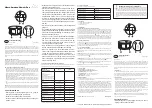
Hardware, Installation and Configuration
2-21
•
the manner in which various interrupts will be triggered: rising or falling
edge, high or low level
•
associations between interrupts, output lines and distributed interrupt lines
•
the name of the system in an RCIM chain that has the master RCIM
•
whether tick clocks are to run locally or be synchronized with the clock of
the master RCIM system in a chain
•
whether the RCIM is registered as a master clock
The
rcim
tunable accepts a comma-separated list of options. For example:
rcim=’host/server1.ccur.com, eti1/rising, di3/high, rtc3|di6’
In this example for an RCIM slave system, the RCIM master system name is
server1.ccur.com, edge-triggered interrupt (eti) #1 is configured to trigger on the rising
edge, distributed interrupt (di) #3 triggers on a high value, and distributed interrupt line
(di) #6 is to be driven by real-time clock timer (rtc) #3.
The sync/nosync options affect clock synchronization across an RCIM chain. “sync”
specifies that the RCIM is to use the cable clock driven by the master RCIM’s local clock.
This is the default.“nosync” specifies that the RCIM uses its local clock.
The clock/noclock options define whether the RCIM is registered as a clocksource for the
system. The default is “clock.” Note that once the RCIM is registered as a clocksource, it
cannot be “unregistered.” Also if the RCIM is configured as a module and registered as a
clocksource, the module will be locked in (‘rmmod rcim” will fail).
On RCIM III and RCIM II systems, the timing sources for RTCs, tick and POSIX clocks
can be configured individually, if desired. For example,
rcim=nosync/r,sync/tp
selects the local clock for the RTCs (
r
) and the cable clock for the tick (
t
) and POSIX (
p
)
clocks. If specifiers are not provided for sync and nosync, all three clocks are set
according to the option in effect.
Dynamic Configuration
1
Configurations can be modified dynamically using
echo(1)
to write a configuration
string, in the format used by the
rcim
tunable, to
/proc/driver/rcim
N
/config
(where
N
is the RCIM card number starting from zero). For example:
echo eti1/f > /proc/driver/rcim0/config
changes eti #1 to trigger on a falling edge. Quotes must be used to surround a
configuration request that contains a vertical bar; for example:
echo “rtc0|di1” > /proc/driver/rcim2/config
Configuration modifications made in this way are not retained when the system is
rebooted. Making these changes requires write permission to the file and should only be
made when the RCIM is not in use.
Refer to Chapter 3 or the
rcim(4)
man page for complete information about
configuration defaults and selections for each interrupt type.
Artisan Technology Group - Quality Instrumentation ... Guaranteed | (888) 88-SOURCE | www.artisantg.com
















































